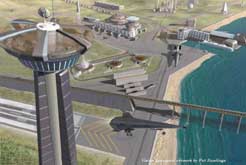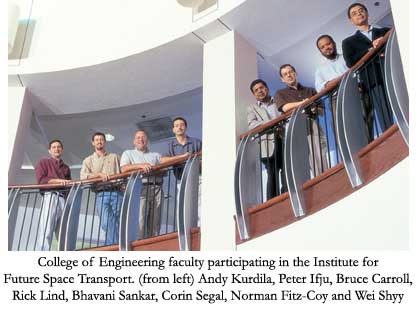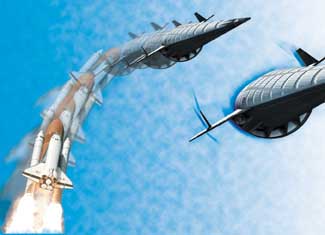
|
A Florida-Led Consortium Of Universities Has Been Selected To Develop Systems For The Launch Vehicle That Will Succeed The Space Shuttle By Joseph Kays |
||
|
It's a good thing the seven astronauts on the space shuttle don't have to pay their own way into orbit, because at $71 million a seat, all the frequent flyer miles in the universe wouldn't make the ticket affordable. The space shuttle has served the United States well for more than 20 years but, at a cost of $500 million per launch, it is prohibitively expensive. So NASA is seeking a more cost-effective way to get people and equipment into orbit, and it has chosen the University of Florida to lead the way. Last June, the space agency awarded a Florida-led consortium of seven universities a $15 million grant to develop the next generation of reusable launch vehicle, or RLV, which would replace the current space shuttles or their successors around 2025. The Institute for Future Space Transport that will be based at Florida will focus on four "research pillars": propulsion technologies, airframe technologies, vehicle maintenance, and systems integration and design optimization. Florida's partners are Cornell, Georgia Tech, Alabama, Syracuse, North Carolina A&T and Prairie View A&M in Texas. Getting away from the rocket technology that has propelled human space exploration from its inception would go a long way toward achieving NASA's ambitious goals for these third-generation, or Gen3, vehicles: a 100-fold reduction to about $100 per pound in launch costs, and a 10,000-fold increase in safety to one death in a million flights. "We will not be able to continue to rely on the space shuttle for frequent low-orbital missions — the costs are just too prohibitive," says Wei Shyy, director of the new institute and chair of Florida's Department of Mechanical and Aerospace Engineering. "Instead, we have to develop technology that will eventually fly spacecraft more like aircraft, in terms of cost, safety and maintenance, and that's the focus of this institute." Since the dawn of the space age, astronauts have escaped the relentless grip of Earth's gravity by perching themselves atop hundreds of thousands of gallons of extremely volatile fuel. But this approach has numerous drawbacks. First, it's dangerous, as the Challenger explosion so horrifyingly illustrated. Second, it's expensive. The average space shuttle flight costs $500 million. Third, it's inefficient. About 84 percent of the shuttle's 4.5- million-pound payload is fuel. The average turn-around time for a space shuttle is six months. But achieving orbit with a plane-like RLV is not just a matter of pointing an F-15 fighter skyward, says Shyy. The technological hurdles to reaching escape velocity of more than 3,000 miles per hour (Mach 5) are many, including identifying new fuels, engine shapes and airframes. Much of the emphasis for the new vehicle will focus on moving away from a reliance on conventional rocket engines. The space shuttle lifts off on two very large solid rocket boosters and then ignites three liquid rocket engines that convert a chemical reaction between liquid hydrogen and liquid oxygen into the kinetic energy needed to put the space shuttle in orbit. A viable alternative, Shyy says, is "air-breathing" engines like those used on jets, coupled with a smaller rocket. Institute executive director Corin Segal, a Florida mechnical and aerospace engineering professor, will spearhead the development of air-breathing propulsion technologies for the new vehicle. Segal anticipates such vehicles would take off from runways like airplanes and make most of the journey into space using hypersonic engines, switching to small rockets for the last boost into orbit. "Fuel is a big cost factor," says Segal. "To take a vehicle that heavy and put it 300 miles above the Earth requires immense amounts of energy. When you do this with chemical rockets, like we do today, you have to carry with you both the propellant and the oxidant. "If we are able to do the air-breathing propulsion, this would reduce substantially the weight of the ship," he continues, "because, with air-breathing engines, the oxidant is coming out of the air rather than being carried as a fuel like on the space shuttle." One of the greatest challenges, Shyy says, is designing an engine technology that gives the fuel time to ignite before it is blown "out the door" by the sheer speed of the vehicle. "Jet fuels burn very fast, but not as fast as we envision these vehicles flying," Shyy says. "For a typical aircraft engine, an extremely efficient 99 percent of the fuel burns, but in tests of an engine like we are talking about, we've been lucky to get positive efficiency at all. The major reason is that the flame cannot burn nearly as fast as the air flows, so before you can ignite it, the mixture is out the door." Shyy says researchers are concentrating their efforts on engine designs that redirect airflow through the engine so the flame has more time to ignite.
"But at such a high speed," he says, "redirecting air flow creates a shock that results in a lot of aerodynamic loss, and a lot more drag, so then you need even more fuel." "The Saturn V was a tremendous accomplishment, but it used brute force," he says. "The space shuttle is a very fine piece of machinery, but the technology, the engineering tools used to design both, were similar." The Gen3 vehicles will have to employ 21st-century technology to achieve NASA's goals, Shyy says, noting that the computing power aboard Apollo 11 was less than on most hand-held calculators today. Florida researchers expect to employ dramatic advances in computers, materials and sensors to achieve both significant cost savings and safety assurances in maintaining the vehicle. Today, engineers conduct a mostly manual inspection of the space shuttles to ensure there are no cracks or other damage that could lead to catastrophic failure. This is a time- and labor-intensive process that contributes significantly to the turn-around time and cost of each mission. But Shyy says designers could blanket a Gen3 vehicle with new miniaturized sensors without adding hardly any weight.
Those sensors could feed information back to computers millions of times more powerful than those available in the past so that flight managers would have a much more comprehensive picture of the vehicle's status at a fraction of the cost.
Shyy believes Florida's technical strengths, its university partnerships and strong backing from industry impressed NASA managers reviewing the more than 100 proposals submitted for the agency's University Research, Engineering and Technology Institutes (URETI) program. "The comments I got were that our proposal was very well structured," Shyy says. "Our diverse team was very well integrated. It was not a case of Florida do this, Cornell do that, then we just staple them all together." Munir M. Sindir, director of advanced analysis processes for Boeing's Rocketdyne Propulsion and Power Division, cited as strengths of the institute the team's knowledge, experience and expertise as well as a willingness to work with industry as partners and a strong focus on teaching and mentoring. "We expect them to show creativity and ‘out-of-the-box' thinking in new technology development and deployment: to focus on ‘revolutionary' versus ‘evolutionary' development," Sindir says. "And we hope they will use the center as a training ground for future aerospace and mechanical engineers." "Teaching students is our main responsibility here," Segal says, adding that the grant will support 19 doctoral students at Florida alone, with more at the other institutions. "This grant ensures that our students are well supported and their work is well defined for a longer period of time."
"People who never thought of Florida as an overall leader in aerospace engineering are definitely taking notice now," says Evanich, adding that the institute can only help strengthen the university's relationship to NASA, specifically the Kennedy Space Center. "After all, Gen3 RLVs will eventually be launched from KSC. Anytime we can bring more NASA work to the state, people will automatically think of Kennedy." "This is a chance to really put our university on the leadership position in this field," says Shyy. "We look forward to making Florida an internationally recognized leader in this important area in engineering as well as human exploration." Wei Shyy Professor and Chair, Department of Mechanical and Aerospace Engineering (352) 392-0961 The conceptual illustrations used in this article were developed through the Space System Design Lab at Georgia Tech, a partner with the University of Florida in the Institute for Future Space Transport. |
|||

|
FLORIDA'S NASA CONNECTIONS EXTEND BEYOND EARTH'S ORBIT |
||
|
Although Florida has a long history of collaboration with NASA, the Institute for Future Space Transport represents the most ambitious of a string of recent grants from the agency to the university. In an effort to recreate Earth's ecosystems in conditions utterly hostile to life, NASA awarded the university a $4.75 million grant to develop new technologies to help grow plants, recycle waste and create breathable air in an artificial ecosystem that is far smaller and more contained than the one on Earth, yet just as complex. Because of the expense and difficulty of transporting fuel, food and oxygen into outer space, scientists believe any mission longer than 18 months in duration will have to rely on “bioregenerative life support," says Rob Ferl, a UF professor of horticultural sciences and the lead scientist on the project's plant growth component. This means scientists must develop the technology for people to be entirely self-sustaining before NASA's planned mission to Mars, which is expected to last three years, and other more ambitious stays in outer space, says Bill Knott, senior scientist at the Kennedy Space Center's biological sciences office. "The way we do it now is basically like a picnic — we take everything with us and we bring all the trash back," Knott says. "Regenerative life support is when we get away from the picnic concept and really go to something that allows us to live in space permanently." However, the challenges to creating an Earth-like life-support system in space are daunting. Naturally adapted to Earth's conditions, plants do not grow well in space. While the decay-regeneration cycle of organic matter works seamlessly here, reproducing it in a small, enclosed space station or colony is a complex engineering problem. Ditto for the natural carbon dioxide-oxygen symbiosis between animals and plants. Ferl says his group will work to genetically engineer oxygen-producing plants in an effort to overcome their resistance to growing in the zero-gravity, low-pressure, low-light conditions of outer space. "We need to learn how to grow plants in a totally new environment," Ferl says. "We have to learn to engineer plants to live at pressures that you and I can't live at." The grant is divided into two parts to address these challenges: human support and plant growth. A third component will seek potential commercial partners and applications for new technologies developed during the research. Mark Law, an electrical and computer engineering professor, heads the human-support portion of the grant. He says engineers are planning four projects aimed at improving water reclamation technologies and creating ultra-small sensors to monitor the reclamation system for potentially unhealthy pollutants or pathogens. "If you're on a long-duration space station, you have to reclaim your water, and one of the tasks is to build a test bed or prototype lab to test our sensors and other technologies that will help us do that," Law says. The grant's commercialization component will seek to identify companies that may be willing to help fund the technologies as they are being developed for Earth-based commercial applications, says Bill Sheehan, director of the engineering college's Environmental Systems Commercial Space Technology Center. Win Phillips, UF vice president for research, says the grant helps UF support Gov. Jeb Bush's goal of making Florida the number one state not only for spacecraft launches but also for space research and technology transfer. "We have the top launch facility at Kennedy Space Center, and our space research and commercialization efforts are rapidly expanding," Phillips says.
Rob Ferl
Mark Law
|
|||
|
While some Florida researchers are working to develop the next generation of launch vehicle, others are seeking ways to launch the current generation more cost effectively. The job of 50 trucks hauling more than 300,000 pounds of hydrogen fuel 600 miles from where it is produced near New Orleans to the Kennedy Space Center costs hundreds of thousands of dollars each time the shuttle roars into orbit. Seeking to develop new technology to produce the hydrogen much closer to the launch pad — and in a more environmentally friendly way — NASA has awarded a group of Florida universities $8.1 million for hydrogen research. The goal of the 18-month program is to come up with new or improved technologies to produce, store and handle hydrogen on the ground and in space. "If you could produce hydrogen on site at Cape Canaveral or right nearby, you could at least cut the cost in half, because the transportation is a huge part of the cost," said James Burkhart, a senior research engineer at NASA Glenn Research Center, the source of the grant. "We're also hoping to find better ways to store and transport hydrogen, both on the ground and in space, where it has also proved challenging to handle." The University of Florida and the University of Central Florida are heading up the research effort, with about $5.4 million going to UCF and about $2.7 million to UF. Other participating universities include the University of South Florida, the University of West Florida and Florida State University. Burkhart said existing industrial hydrogen production centers are not only too far away from the cape, but also rely on technology that releases large amounts of carbon dioxide into the atmosphere. Although the amount of this so-called greenhouse gas released as a result of shuttle hydrogen production pales in comparison to the amount produced by cars or power plants, NASA would like to find a cleaner alternative — especially because it views space flight as a growth industry, Burkhart said. There are at least 18 proposed new technologies, including processes that use solar energy, electricity and lasers to release hydrogen from water. Burkhart said the main goal of the Florida research is to test these technologies and zero in on the most promising ones. Yogi Goswami, a professor of mechanical engineering and director of UF's Solar Energy and Energy Conversion Laboratory, is the lead UF researcher in the program. He said another goal of the research is to find better ways to transport and store hydrogen, which requires extremely low temperatures to be kept in liquid form. Currently, much of the hydrogen intended for use on the shuttle is wasted because it "boils off" or evaporates, Burkhart said. For example, each time NASA fuels up the shuttle, it loses 97,000 pounds of hydrogen, requiring the agency to bring in almost a third more hydrogen than the 227,000 pounds required for the main tank. Goswami and Burkhart noted that although the research is targeted at space, the results could well have applications on Earth. Hydrogen has long been seen as an alternative to the fossil fuels that power the majority of the world's automobiles, but the costs of producing the gas and the difficulty of storing it have long proved to be significant roadblocks.
D. Yogi Goswami
|
|||

 "The sensors used to be so big that you couldn't include very many on the vehicle. Now you can really do things at such small scale that you can cover the vehicle with them," Shyy says. "And, you have much faster computers now that you can rely on to give you the data to do diagnostics. These are two key pieces of the puzzle, and these are things that we do well."
"The sensors used to be so big that you couldn't include very many on the vehicle. Now you can really do things at such small scale that you can cover the vehicle with them," Shyy says. "And, you have much faster computers now that you can rely on to give you the data to do diagnostics. These are two key pieces of the puzzle, and these are things that we do well."
 Peggy Evanich, who came to Florida to enhance the university's relationships with NASA after working for the space agency for 27 years, says getting the URETI grant has dramatically enhanced Florida's reputation in the aerospace community.
Peggy Evanich, who came to Florida to enhance the university's relationships with NASA after working for the space agency for 27 years, says getting the URETI grant has dramatically enhanced Florida's reputation in the aerospace community.
 RESEARCHERS SEEK WAYS TO MOVE HYDROGEN PRODUCTION CLOSER TO SHUTTLE
RESEARCHERS SEEK WAYS TO MOVE HYDROGEN PRODUCTION CLOSER TO SHUTTLE